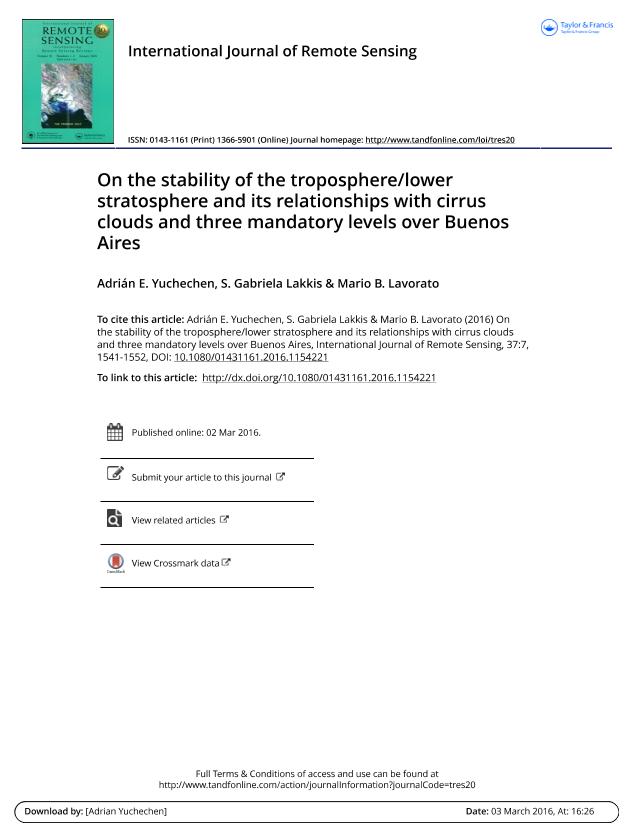Mostrar el registro sencillo del ítem
dc.contributor.author
Yuchechen, Adrian Enrique

dc.contributor.author
Lakkis, Susan Gabriela

dc.contributor.author
Lavorato, Mario Blas

dc.date.available
2018-04-27T19:37:27Z
dc.date.issued
2016-03
dc.identifier.citation
Yuchechen, Adrian Enrique; Lakkis, Susan Gabriela; Lavorato, Mario Blas; On the stability of the troposphere/lower stratosphere and its relationships with cirrus clouds and three mandatory levels over Buenos Aires; Taylor & Francis Ltd; International Journal of Remote Sensing; 37; 7; 3-2016; 1541-1552
dc.identifier.issn
0143-1161
dc.identifier.uri
http://hdl.handle.net/11336/43722
dc.description.abstract
An unrotated principal components analysis was carried out to establish the most representative modes for the joint variability between the heights of the upper and lower boundaries of cirrus clouds and three different mandatory levels (850, 500, and 100 hPa), and the associated stability of the troposphere over Buenos Aires. Discussion is limited to the first three most representative structures found, which consists of spatial patterns (or empirical orthogonal functions, EOFs) and their time-evolving coefficients (or principal components, PCs). EOF1 shows a direct (indirect) mode that encompasses the cirrus slightly below (above) its mean position, with 500 and 100 hPa exhibiting a similar behaviour and 850 hPa acting the opposite way. EOF1 is associated with above-normal stability (instability) for direct (indirect) modes (i.e. positive (negative) values of PC1). On a monthly average, this occurs in the austral winter (summer) months. Regarding EOF2, all three mandatory levels experience positive (negative) height anomalies in direct (indirect) modes and cirrus goes up (down) under mild stability (instability). Monthly averages show that PC2 is approximately positive in summer and in early fall and negative the rest of the year. As to EOF3, it is characterized by a stability similar to that of EOF2, with direct (indirect) modes showing lowered (raised) cirrus and all three mandatory levels above (below) normal conditions; on a monthly basis, PC3 is best described as having a semi-annual evolution, with maxima (minima) in March and October (January and August). Overall, EOF1 has the highest stability or instability, depending upon the sign of PC1. These results are the first of their kind worldwide.
dc.format
application/pdf
dc.language.iso
eng
dc.publisher
Taylor & Francis Ltd

dc.rights
info:eu-repo/semantics/openAccess
dc.rights.uri
https://creativecommons.org/licenses/by-nc-sa/2.5/ar/
dc.subject
Principal Components Analysis
dc.subject
Cirrus Clouds
dc.subject
Stability Indices
dc.subject
Mandatory Levels
dc.subject.classification
Meteorología y Ciencias Atmosféricas

dc.subject.classification
Ciencias de la Tierra y relacionadas con el Medio Ambiente

dc.subject.classification
CIENCIAS NATURALES Y EXACTAS

dc.subject.classification
Meteorología y Ciencias Atmosféricas

dc.subject.classification
Ciencias de la Tierra y relacionadas con el Medio Ambiente

dc.subject.classification
CIENCIAS NATURALES Y EXACTAS

dc.subject.classification
Astronomía

dc.subject.classification
Ciencias Físicas

dc.subject.classification
CIENCIAS NATURALES Y EXACTAS

dc.title
On the stability of the troposphere/lower stratosphere and its relationships with cirrus clouds and three mandatory levels over Buenos Aires
dc.type
info:eu-repo/semantics/article
dc.type
info:ar-repo/semantics/artículo
dc.type
info:eu-repo/semantics/publishedVersion
dc.date.updated
2018-04-27T13:58:51Z
dc.journal.volume
37
dc.journal.number
7
dc.journal.pagination
1541-1552
dc.journal.pais
Reino Unido

dc.journal.ciudad
Londres
dc.description.fil
Fil: Yuchechen, Adrian Enrique. Consejo Nacional de Investigaciones Científicas y Técnicas; Argentina. Universidad Tecnológica Nacional. Facultad Regional Buenos Aires. Unidad de Investigación y Desarrollo de las Ingenierías; Argentina. Pontificia Universidad Católica Argentina "Santa María de los Buenos Aires". Facultad de Ciencias Fisicomatemáticas e Ingeniería; Argentina
dc.description.fil
Fil: Lakkis, Susan Gabriela. Universidad Tecnológica Nacional. Facultad Regional Buenos Aires. Unidad de Investigación y Desarrollo de las Ingenierías; Argentina. Pontificia Universidad Católica Argentina "Santa María de los Buenos Aires"; Argentina
dc.description.fil
Fil: Lavorato, Mario Blas. Ministerio de Defensa. Instituto de Investigaciones Científicas y Técnicas para la Defensa; Argentina
dc.journal.title
International Journal of Remote Sensing

dc.relation.alternativeid
info:eu-repo/semantics/altIdentifier/doi/https://dx.doi.org/10.1080/01431161.2016.1154221
dc.relation.alternativeid
info:eu-repo/semantics/altIdentifier/url/https://www.tandfonline.com/doi/full/10.1080/01431161.2016.1154221
Archivos asociados
